
Take a closer look
Antimicrobial Gait Belt Details
Antimicrobial Gait Belt Benefits
- Help keep patients as well as caregivers safe from germs and bacteria
- Help a patient stand or sit
- Help an individual rise from the floor
- Patient transfers from bed, wheelchair, toilet or car
- Provide support while walking
- Protect patients who are unstable when standing
- Help patients maneuver when using the bathroom
- Reduce the risk of back injury to patient and staff during patient transfers
Who Needs an Antimicrobial Gait Belt?
- Patients and caregivers in institutional settings where germs and bacteria are a concern
- People who have trouble balancing
- People who are too weak to stand alone
- Nurses who help the above
When to Use Gait Belts
Use gait belts when transferring cooperative patients who are capable of bearing some of their own weight. For patient transfers such as from bed to chair or chair to car, when repositioning patients in chairs, supporting patients during ambulation, and in some cases when guiding and controlling falls, and helping a patient after a fall.
After a fall, the caregiver should always assess the patient for injury before attempting to move them. If the patient can regain a standing position with minimal assistance, use a gait belt or transfer belt with handles to help. Keep your back straight, bend legs, and stay as close to the patient as possible. If the patient cannot stand with minimal assistance, you may want to consider enlisting outside help or the use of a powered portable or ceiling-mounted lift device to move the patient.
When Using Any Gait Belt, Keep in Mind:
More than one caregiver may be needed. Always transfer to patient's strongest side. Use good body mechanics and a rocking and pulling motion rather than lifting. Gait belts may not be suitable for ambulation of heavy patients, or patients with recent abdominal or back surgery, abdominal aneurysm, etc. Should not be used for lifting patients. Ensure that gait belt is securely fastened and cannot be easily undone by the patient during transfer. Ensure a layer of clothing is between patients' skin and the gait belt to avoid abrasion. Keep patient as close as possible to caregiver during patient transfer. Lower bedrails, remove arms and foot rests from chairs, and other items that may obstruct the patient transfer.
SKU: 70257, 70256, Antimicrobial Gait Belts, Gait Belt, Gait Belts, Transfer Belt, Transfer Belts
